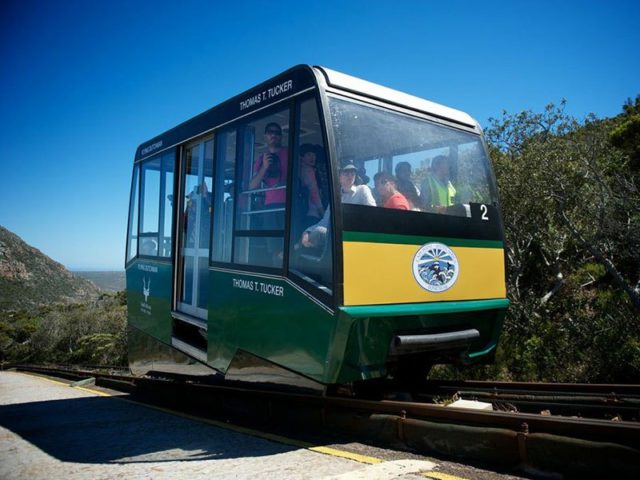The Cape of Climbs
The Funicular Trams
A tough trip to the top
In 1877, the lighthouse keeper at the Cape Point lighthouse began to keep a visitor’s book. The objective was partly for his own records and amusement, and partly to reward those who had made the arduous trip.
“Hades of an ascent,” gasped one early entry.
“Some climb,” panted another.
“We want a road,” squealed a third.
To give you an idea of how difficult the trek to the lighthouse was, between 1877 and 1915 there were only about 70 entries per year into the lighthouse keeper’s visitors books. And if you consider that most visitors’ groups consisted of at least 5 people per group, that’s an average of only 14 visits per year!
In 1915 a decent road was built and visitor numbers ticked up but the climb from the road to the lighthouse was still prohibitively arduous.
Of bus services and upgrades
Before the funicular railway was built in 1996, there was a bus service that transported people from the car park to the staging point, from where they could make their way to the lighthouses and viewing sites. (The main restaurant in Cape Point was in the Buffelsvlei building – where the Information Centre is today.)
The original bus was called The Flying Dutchman, after the famous ghost ship whose Captain Van der Decken was cursed to sail the stormy waters round Cape Point. The American writer Michael Fraser immortalized the original bus service in a passage that deserves eternal repetition:
“Destined, like its namesake, to never round the Cape, and doubly cursed to never get out of second gear, the roaring blue beast strains its way interminably up and down the steep road, the bus driver undoubtedly uttering his own Van der Decken-like oaths when American tourists in tartan shorts and a world of their own wander dreamily across his bows, requiring that the anchor be dropped rather precipitately for the sake of harmonious international relations.”
In 1995, a construction company called Concor Holdings (the same company that reconstructed the Sea Point swimming pool and built the Hartleyvale Olympic hockey stadium in Observatory) received a contract from the Cape Metropolitan Council to create a tourist facility at Cape Point. The facility would include a scenic restaurant, kiosk, information centre and a shiny new funicular railway to replace the accursed bus service.
The funicular
The word ‘funicular’ comes from the Latin word funis, which means rope – a clue to the aspect of this particular technology that makes it unique. A funicular railway uses two rail trams attached to one another with a cable. The counter-weight of each car produces a part of the power required to move each car up and down the steep slope.
The Cape Point funicular took its name from the bus service that preceded it, but these days it is much smoother sailing. The rails upon which the cars are set is proudly a South African invention – the brainchild of one Peter Kussel of the Tubular Track company. Unlike conventional railway tracks, the tubular tracks are laid on twin reinforced concrete beams tied together using galvanized steel tie bars – an innovative engineering concept.
The top station of the funicular was once the staff quarters of the original 1860 lighthouse. (Which was replaced by the newer, lower lighthouse in 1919 because it was frequently obscured by mists.) Today it is a curio shot and kiosk.
Construction delays
Construction of the funicular started in 1995. As so often happens with projects of this nature, there were some unexpected delays. A selection of newspaper reports tells the story:
“…the system will only be competed after February next year.” – Weekend Argus, 21 October 1995
“It is hoped to have the funicular completed by March next year.” – Weekend Argus, 25 November 1995
“Construction of the track has already started and the entire project is expected to be commissioned (sic) before April 1996.” – Engineering News, 24 November 1995
“The R3,5m environmentally friendly, locally made funicular rail system… is nearly ready.” – Weekend Argus, 6 July 1996
“DELAYED CAPE POINT CABLE RAILWAY WILL OPEN BY END OF YEAR” – Weekend Argus, 5 October 1996
“Cape Point’s long-awaited funicular will finally open on Monday morning after months of delay.” – Weekend Argus, 1 December 1996
“The long-awaited opening of the Cape Point funicular was set back a gain when a computer fault shut down then system.” – Cape Argus, 3 December 1996
Until, at last:
“FUNICULAR IN TIMELY DEBUT” – Cape Times, 19 December 1996 (The editor of the Weekend Argus had presumably stopped sending his reporters to the events.)
The funicular today
Today, nearly one million people make the journey to Cape Point every year, and 378,000 of them use the funicular to get to the lighthouse.
It’s safe, it’s smooth, it’s silent, and it’s a lot more environmentally friendly than a bus. (The winch at the top is electric.) The funicular is able to transport up to 450 people per hour – 40 people per car – at 16km/h for the 585 metres between the parking lot and the staging point below the lighthouse. It employs 14 people.
We’re sure you’ll agree: it was worth the wait.
You’ve read the story of the funicular, now head to Cape Point where you can:
- Buy a ticket to ride it!
- Note the special tracks, and the point at which the funicular cars cross pone another at the halfway point.
- You can also take a walk back down along the road that was used by the original Flying Dutchman bus.
- Have lunch at the Two Oceans Restaurant, which forms part of the concession in which then funicular was built.
*Source: Cape Point


